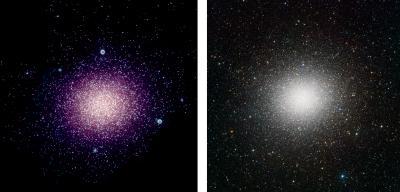A large new collection of space photos taken at wavelengths that are invisible to the human eye and blocked by Earth's atmosphere has been released as a New Year's gift to the people of Earth by NASA and Penn State University. The images were captured by a telescope on board NASA's Swift satellite, whose science and flight operations are controlled by Penn State from the Mission Operations Center in State College, Pennsylvania, using the Ultraviolet/Optical Telescope, which resulted from Penn State's collaboration with the Mullard Space Science Laboratory of the University College-London. The telescope is one of just a few that study ultraviolet light, much of which is blocked by the atmosphere surrounding Earth.
"This extensive image gallery has some of the best pictures ever taken by this telescope, including some very early images that have not been published until now," said Michael Siegel, a Penn State research associate in astronomy and astrophysics who is the lead scientist for the Ultraviolet/Optical Telescope. The image gallery is online at http://www.swift.psu.edu/uvot/coolPics.php, and it also can be viewed with the free Swift Explorer Mission iPhone app developed by Penn State.
The image gallery includes images from Siegel's study of the Omega Centauri star cluster, Penn State Research Associate Erik Hoversten's studies of galaxies near to our Milky Way Galaxy, and NASA Astronomer Stefan Immler's work on the early images captured by the Swift observatory. "We intend to keep updating the gallery about once a month with new images from Swift as well as an interesting collection of images that document stages in Swift's preparation for launch into space," Siegel said. "We also plan to continue adding spectacular images from several new long-term studies of the Small Magellanic Cloud and the Large Magellanic Cloud."
In addition to Siegel and Hoverstein, other current and former Penn State members of the image-gallery team include Undergraduate Students Joshua Berrier, Emmanuel Fonseca, and Blair Porterfield; Research Assistant Michael Stroh; and Research Associate Jamie Kennea.

One of the first targets for the Swift observatory's stellar survey was the giant cluster Omega Centauri, which hosts millions of stars and may be the remains of a small galaxy. Omega Centauri (also known as NGC 5139) is the largest, brightest and most massive of our galaxy's 150 or so globular star clusters. Packing some 10 million stars into a region just 150 light-years across, Omega Centauri is easily visible to the unaided eye despite lying nearly 16,000 light-years away. Unlike other star clusters, whose members all have similar age and chemical makeup, Omega Centauri displays a wide range of age and chemistry, from the ancient (12 billion years) to the relatively recent. This presence of different stellar populations suggests that Omega Centauri is not, in fact, a globular cluster, but the remnant core of a dwarf galaxy torn to shreds by the Milky Way's gravity. The false-color ultraviolet composite from images taken through Swift UVOT's ultraviolet filters reveals a treasure trove of rare stars in various stages of demise.
(Photo Credit: for image on left: NASA/Swift/S. Holland (Goddard Space Flight Center), M. Siegel and E. Fonseca (Pennsylvania State University) for image on right: A. Grado/INAF-Capodimonte Observatory. Captured by the VST ESO/INAF-VST/OmegaCAM.)
The Ultraviolet/Optical Telescope (UVOT) is the only one of the three telescopes on Swift that captures cosmic light at energies at and just beyond those that can be seen by the human eye. It plays a critical role in rapidly pinpointing the locations of gamma-ray bursts (GRBs), the brightest explosions in the universe. Swift has detected an average of about 90 GRBs a year since its launch in 2004. "When we are not studying GRBs, we use the satellite's unique capabilities to engage in other scientific investigations, some of which produce these beautiful images from the UVOT that we're now delighted to be able to share with the public," Siegel said. The targets for these studies range from comets and star clusters to supernova remnants, nearby galaxies, and active galaxies powered by supermassive black holes.
"One of our more challenging projects was completing an ultraviolet mosaic of M31, the famous Andromeda galaxy," said Stefan Immler, a member of the Swift team at NASA's Goddard Space Flight Center in Greenbelt, Maryland. "Because the galaxy is so much larger than the UVOT's field of view, we had to take dozens of pictures and blend them together to show the whole object."
Because most ultraviolet light never reaches the ground, Swift's Ultraviolet/Optical Telescope provides a unique perspective on the cosmos. For example, it can measure the amount of water produced in passing comets by detecting the ultraviolet emission of hydroxyl (OH), one of the molecular fragments created when ultraviolet sunlight breaks up water molecules. Other types of science with the telescope include exploring emissions from the centers of active galaxies, studying regions undergoing star formation, and identifying some of the rarest and most exotic stars known.
With Swift's Ultraviolet/Optical Telescope, astronomers at NASA's Goddard Space Flight Center and Penn State have cataloged hundreds of rare types of stars and are now comparing their observations with theoretical models in order to advance the understanding of how stars evolve. "The Swift Ultraviolet/Optical Telescope's capabilities give us a great tool for cataloging rare types of ultraviolet-bright stars and for surveying stellar populations throughout the universe," Siegel said.

NGC 7331 is a luminous edge-on spiral galaxy about 45 million light-years away in the constellation Pegasus. If we could view our own Milky Way galaxy from the outside, it might look very similar to this NGC 7331 galaxy. At left and center, respectively, are Swift images captured through the Ultraviolet/Optical Telescope's optical and ultraviolet filters. The panel at right shows X-ray observations (0.2-10 keV) from Swift's X-ray Telescope.
(Photo Credit: : NASA/Swift/S. Immler)
Source: Penn State